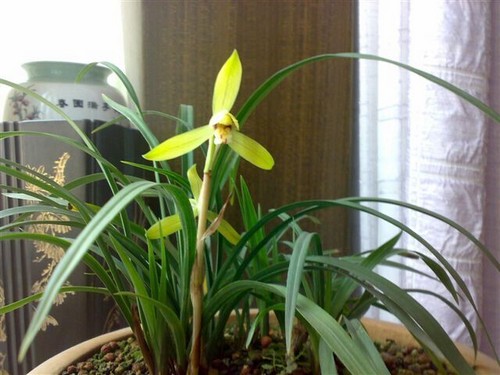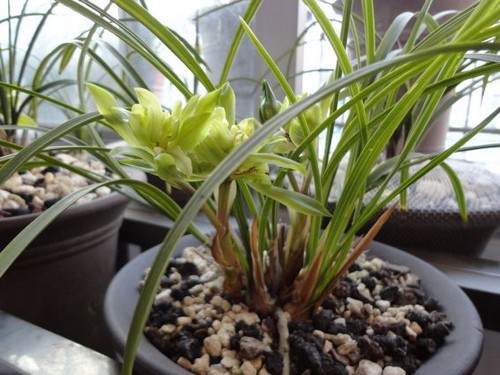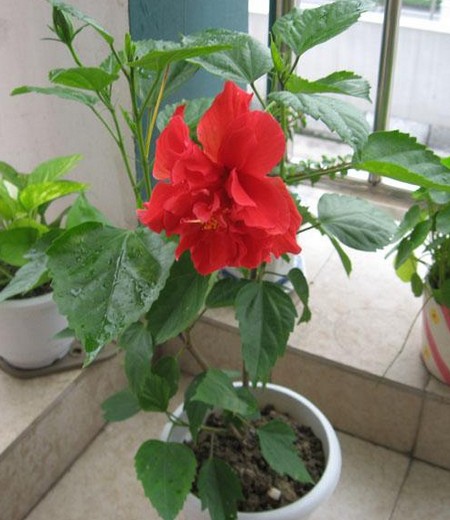How to raise spring orchids in the family
Chunlan is a typical representative of the petal flower of the national orchid, which has been widely spread since ancient times. Chunlan has a wide range of famous products with stable and moderate prices, which can be accepted by ordinary enthusiasts. But it is cheap to buy and expensive to raise. Take a look at how to raise Chunlan in the family!

The environmental requirements of Chunlan:
Cymbidium prefers cool, half-yin and half-yang environment, which does not need much fertilizer, but has a high requirement for humidity, and grows well in the environment with large temperature difference between day and night. The most ideal place in the north is of course the outdoor closed balcony, the environment is properly modified, installed with shade, humidification, ventilation equipment, Chunlan will grow very strong. But if it is stocked, it will not grow very well.
Selection of Cymbidium seedlings:
First of all, you need to compare the environment at home, choose orchid seedlings with similar environment, lest environmental differences affect growth too much. It is best not to choose seedlings, you can choose the orchid seedlings that have been growing in the transitional garden for a year. The roots are strong, the leaves are many and thick, and the growth is robust. This kind of orchid seedlings is easier to maintain at home.
More than three years of old Miao is not desirable, beware of drawing Miao, carefully consult the merchants when buying.
Maintenance of Chunlan:
1. Use soil: new plants should choose clean and fine-grained soil. Planting gold stone has strong water retention, and it is an ideal plant material for breeding high-grade spring orchids, equipped with granular humus soil and basin cover water moss to moisturize. After the orchid plant adapted to the environment, the content of humus soil was gradually increased.
2, summer buckle water, autumn moisturizing, winter and spring: summer temperature is higher, water evaporation is large, but also can not be uncontrolled watering, need appropriate buckle water, more conducive to the growth of spring orchids. Pay attention to moisturizing when the weather is dry in autumn. There is heating in the north in winter, which is not conducive to the growth of flower buds in Chunlan, so it should be moved to the outdoor balcony and the temperature should not be too high.
3. Fertilization: spring orchids do not need much fertilizer, so they should be kept clean and wet. Non-strong seedlings do not apply heavy fertilizer, non-strong seedlings do not dry raise.
4. Dividing the basin: the spring orchid propagated in the high temperature and humidity environment in the south, the flowering consumes little nutrition, the germination rate is very high, and it can germinate 4 times a year. Due to the insufficient nutrition reserve and excessive consumption of seedlings, the speed of grass withdrawal is faster in the dry environment in the north. The germination rate of the newly introduced Cymbidium is usually very high in the first year, but this does not mean that it has adapted to the new environment. After 3 years of breeding, the biological clock gradually stabilized with the adjustment of the new environment. Therefore, after 1-2 years of introduction, the old and weak seedlings should be removed in time to reduce consumption and promote the growth of strong seedlings.
Spring orchid is one of the common varieties of indoor flowers. Spring orchid blossoms with delicate fragrance and high ornamental value. Let's take a look at its breeding methods:
1. Requirements for basin soil
The neutral and acidic soil with a large amount of rot, loose and good drainage is the best, and the PH value is generally about 5.5 to 6.5.
2. Place of placement and its location
Orchids can be cultivated outdoors and on the balcony in spring, summer and autumn, and choose places with good ventilation, moist air and no environmental pollution. It is best to be close to the pond and the riverside.
3. Proper shading
Orchids need proper shade, can go to the first and middle of April to open windows, more sunshine to promote its growth. In May, except for the noon sun, it can shine for 6 hours; from June, it will be shaded all-weather, and after October, it can be fully open for maintenance except Zhongyang.
4. Maintain nutrients
The stem of the withered flower should be cut off as soon as possible so as not to consume nutrients and affect the germination of axillary buds. After pedicel removal, 0.1% omethoate or dichlorvos solution is dipped in soft gauze or cotton ball, and the leaf surface and back of the orchid are gently rubbed to remove eggs, dust and stains.
5. Adjust the light properly
Although orchids like a cool and ventilated environment, they also need proper sunlight. Adjust the light reasonably to facilitate the healthy growth of orchids. Generally speaking, green leaves, exotic flowers and dwarf orchids need 60% of the all-day sunshine in spring and 50% in the future, while line orchids need 50% of all-day sunshine in spring and 30% in the future.
In order to adjust the light, families who grow flowers on the balcony can set up a movable plastic support on the balcony, which takes time to open and does not need to be covered, so as to ensure the illumination time of orchids.
6. Reasonable supply of fertilizer
When the orchid plant is dormant, semi-dormant and just put on the pot, the fertilizer can not be absorbed; in the season of high air humidity, too much fertilizer and water will increase the heavy burden on the root system of the orchid. In order to ensure safety, orchids generally do not apply fertilizer during the dormant period, and it is not suitable to apply fertilizer on the roots when the plants are just put on the pot.
7. Proper watering
It is better for orchids to be watered with Rain Water and spring water, and tap water or rice water should be used overnight. When watering, pour from the edge of the basin, not into the bud. The amount of water should be determined according to the air temperature, the degree of dryness and humidity of the basin soil and the growth of orchid grass. The leaves are mostly watered, but the leaves are thinly watered. From April to May, the new bud has not yet grown soil, the basin soil should be dry, too wet new bud is easy to rot; June-September is the orchid bud growth period, the amount of water should be increased, every sunny morning or watering once, do not water at noon hot sun. To reduce the amount of water in autumn, foliar spray water can be used to keep the basin soil moist, and the amount of water should be controlled in winter to keep it "80% dry and 20% wet".
8. Regular sterilization and disinfestation
Around the place where orchids are cultivated and flowerpots, virus clear, chlorothalonil and other drugs can be sprayed once every 7 days, and insecticides such as omethoate and trichlorfon are sprayed every 10 days. It should be noted that 2 hours after the application of insecticidal drugs, the foliage of orchids should be sprayed with clear water to avoid drug damage.
9. Evening spray
Orchids originally grow in humid air, so in the dry season, in addition to shading, they must also be sprayed in the evening to increase air humidity and lower the temperature; they can also be watered on the potted orchid ground (Mesa). "one cold and one hot" can better stimulate the growth of orchids.
10. Guard against wind and rain
Cut off the withered branches and leaves. Orchids can be caught in light rain, but avoid moldy rain, heavy rain or continuous rain, otherwise they are prone to rotten hearts and rotten leaves. In Rain Water's season, you can sprinkle a small amount of plant ash appropriately.
11. Measures to prevent cold and keep warm
Orchids have different varieties, different places of origin, and different cold resistance, so the time of entering the room in winter and the location placed indoors are also different.
Cold orchid, autumn orchid and orchid grow in the south, it is appropriate to enter the room (or close the window and fence) when the temperature is 5 ℃, and put it in the south sunny place as far as possible. However, spring and summer orchid have strong cold resistance and can not enter the room until 0 ℃. When there is no wind in a sunny day, open the window and draw the net for ventilation. Qiulan can not open windows on a sunny day of 1 ℃ 2 degrees Celsius, but can use electric heating.
Time: 2019-06-01 Click:
- Prev

Culture methods of spring orchids
Spring orchid is a very valuable orchid variety, with beautiful, noble, simple, virtuous, virtuous, elegant and other moral symbols, can be given as a gift to friends and so on. Spring orchid is a famous variety of flowers, which can be used in the middle of home to decorate and beautify the house. it can also be used as medicine and given to friends as gifts
- Next

Culture methods and matters needing attention of Fusang flower
Fusang is commonly known as hibiscus, also known as hibiscus, safflower, Chinese rose. Fusang is a beautiful ornamental flower with large color and long flowering period. in addition to red, there are different varieties such as pink, orange, yellow, pink edge, red heart and white. In addition to single petal, there are double varieties.
Related
- Fuxing push coffee new agricultural production and marketing class: lack of small-scale processing plants
- Jujube rice field leisure farm deep ploughing Yilan for five years to create a space for organic food and play
- Nongyu Farm-A trial of organic papaya for brave women with advanced technology
- Four points for attention in the prevention and control of diseases and insect pests of edible fungi
- How to add nutrient solution to Edible Fungi
- Is there any good way to control edible fungus mites?
- Open Inoculation Technology of Edible Fungi
- Is there any clever way to use fertilizer for edible fungus in winter?
- What agents are used to kill the pathogens of edible fungi in the mushroom shed?
- Rapid drying of Edible Fungi

